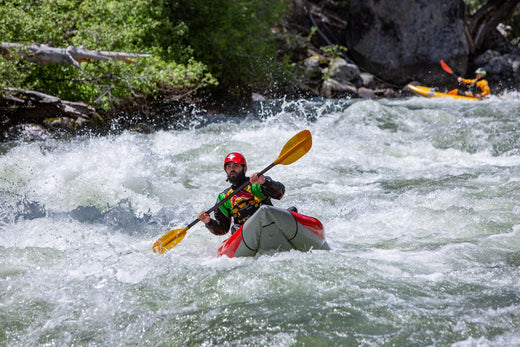10 Types of Whitewater Rafts: Choosing the Perfect Raft
September 10, 2024

Whitewater rafting is an incredible way to experience the water. Still, there are different types of whitewater rafts, and choosing one will significantly influence your adventure.
Understanding the different types of rafts is essential whether planning a technical Class V run or starting on gentler rapids. Let's explore them so you can make the best choice for your next river adventure.

Types of Whitewater Rafts
From splashing rapids to the thrill of navigating through fast-moving water, whitewater rafting is deeply tied to your type of raft. Before buying a whitewater raft, consider each type's unique features and abilities, making the choice of raft crucial to the overall experience.
Catarafts
Catarafts, or "cats," are known for their exceptional stability and maneuverability, particularly in high-water conditions. They are built without an inflated floor, which reduces drag and increases their ability to handle technical rivers. However, they don't haul as many passengers as a raft can, and they can be a little more susceptible to flipping in more giant waves and holes if their line is off.
Paddle Rafts
Paddle rafts are the most popular choice for whitewater rafting, particularly for Class III-IV rapids. These rafts require a coordinated crew, guided by a skilled leader, to navigate the river. Newer paddle rafts often feature three thwarts, which provide added stability and make them ideal for challenging waters. These rafts are highly participatory, with everyone paddling in unison, making them a favorite for commercial and recreational excursions.
Oar/Paddle Combo Rafts
If you're seeking a lot of control, especially on high-volume rivers, an oar/paddle combo raft is an excellent choice, sure to make for some of your best rafting trips. This setup combines the power of rafting oars using a more petite stern-mounted frame with the versatility of additional paddlers, allowing for extra power versus precise maneuvering in challenging conditions.
Gear Rafts
Gear rafts are essential for multi-day trips. They are designed to carry large amounts of equipment while maintaining stability. These rafts require careful rigging and setup but compensate with ample storage space, making them ideal for extended expeditions. Managing passenger safety is critical, especially if you've heavily loaded the raft.
Motor Rafts
Motor rafts are more common in large rivers like the Colorado in the Grand Canyon, where they can capably handle high flows and carry significant loads. These rafts are equipped with motors that allow them to navigate long distances with minimal rock interference. They are ideal for large groups and extended trips, where the ability to cover ground quickly is essential.
Specialized Whitewater Crafts
Pack Rafts
Pack rafts are ultra-light, portable, inflatable kayaks designed for backcountry adventures. Their designs allow them to carry more gear than a typical inflatable kayak. They are compact enough to carry in a backpack but rugged enough to handle technical whitewater. Their versatility and minimal weight make them popular among adventurers who need a craft they can easily transport over land and water.
Dories
Dories are boats made of wood, aluminum, or fiberglass/composite materials that offer a highly maneuverable and, therefore, exciting ride. Their ability to navigate tight river features makes them a favorite among experienced rafters. However, they require skillful handling to avoid damage, especially in rocky or technical river sections.
Sweep Boats
Sweep boats are large, gear-heavy crafts that require expert navigation skills. Typically, commercial guides operate sweep boats — it's rare to see one in private use.
All of these whitewater rafts are far different than the leisurely river tubes that people float on in calm waters.

Self-Bailing vs. Non-Self-Bailing Rafts
When selecting a raft for whitewater adventures, one vital factor to consider is whether the raft is self-bailing or non-self-bailing. This choice directly affects how water drains from the raft as you navigate rapids.
Non-Self-Bailing Rafts
Non-self-bailing rafts, often called "bucket boats," do not have any built-in drainage system. As the raft moves through rapids, water can enter the boat, but it will remain inside until you remove it — often with a bucket, hence the name. Bucket boats can still be a solid choice for recreational use in calm water or mild whitewater conditions. However, continuously removing water can become a significant challenge in heavier rapids.
Self-Bailing Rafts
On the other hand, self-bailing rafts are designed with perforated floors that automatically drain water out through the floor as it enters. These rafts are extremely popular for whitewater rafting, especially in rougher, more technical waters, where a constant influx of water is inevitable. The floor is raised slightly above the bottom of the tubes, allowing water to flow out of the raft through small holes, ensuring that the raft remains light and easy to maneuver even as water continuously splashes in.
Types of Self-Bailing Floors
Laced-in floors: These self-bailing floors are attached to the raft's main body with ropes or straps. They offer durability and are easy to repair or replace if needed. However, the ropes and straps can create minor drag in the water, slightly reducing the raft's speed and agility.
Welded-in floors: Welded-in floors are permanently attached to the raft, making them more rigid and faster in water. These floors also tend to be more watertight, offering a smoother ride with less chance of water seeping through the edges. However, repairs are more onerous if damage occurs.
Drop-stitch floors: This advanced self-bailing floor design uses drop-stitch construction, which inflates the floor to higher pressure, providing more rigidity. These rafts often feel like they have a solid platform underneath, which can offer superior buoyancy and handling in technical whitewater.
Each design has advantages, depending on your needs and the type of water you're navigating. While some still prefer bucket boats, many rafters today favor self-bailing designs for their practicality in rough waters.
What Is R-2ing?
You might see references to two-person rafts or R-2ing, also known as "rafting with two people." R2 rafts are just two people in a paddle raft, sometimes called mini rafts.
Setups like these are small and agile, perfect for navigating technical rivers with rocky terrains, such as Class V rivers. They offer greater control, making it easier to maneuver around rocks, and the minimal crew and equipment mean quicker responses to river conditions.
These smaller rafts are famous among boaters who prioritize maneuverability over carrying capacity. However, while they excel in low-volume runs, they can struggle in big water due to their smaller size and relative lack of weight.
Selecting the Right Raft
Choosing the proper raft depends on various factors, including the river's intensity, your expertise as a rafter, and the type of journey you're planning. Critical considerations include stability, maneuverability, gear storage, and the raft's material. For many, a 14-foot to 16-foot raft will be suitable for many conditions. However, the proper raft for you will depend on your specific needs and the nature of your adventure.
When selecting a raft, consider its material composition and tube diameter, which affect its stability and comfort. It's not so much the materials themselves as their quality, the competency of the manufacturer in assembling them, and their willingness to stand behind their products if something goes wrong. For example, some PVC-based rafts offer a better and more extended warranty than the few rubber-based boats on today's market.
Safety
Regardless of your raft type, ensuring the proper weight distribution, equipment, and safety protocols can significantly impact the success of your trip. Plan by packing the appropriate safety equipment, such as your helmet, life jacket, water shoes, first aid kit, and other essentials.
Frequently Asked Questions
What makes for a successful whitewater adventure?
A successful whitewater adventure requires safety preparation, understanding the significance of weight considerations for different rafts, and choosing the right type of raft to suit your group's size and preference.
What are some types of rafts suitable for a whitewater adventure?
Options include paddle rafts, two-person rafts, oar/paddle combo rafts, gear rafts, catarafts, and motor rafts. You can also consider dories, mini rafts, sweep boats, and pack rafts.
Does the material of the raft have any bearing on its performance?
While a raft's material can impact its performance in different whitewater scenarios, a more critical factor is its build quality. Tube diameter, length, width, kick/rocker, and floor design also impact a raft's performance.
What are the safety measures to ensure an enjoyable whitewater rafting experience?
Proper safety measures include:
- Acquiring adequate safety equipment.
- Understanding water currents and rapid classifications.
- Training for raft maneuvering.
- Properly condition yourself ahead of your trip.
Is there a specific raft better suited for certain group sizes and preferences?
Due to their size, mini rafts are better suited for smaller groups. Expedition and motor rafts can accommodate larger groups. Paddle rafts are recommended for groups that want to actively participate in challenging rapids as a team effort.

